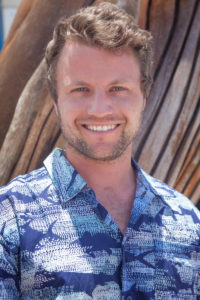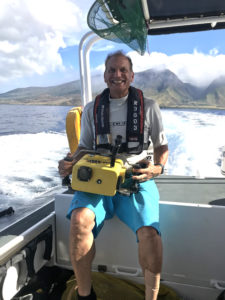Free Talk on Factors Contributing to Declining Humpback Whale Sightings in Hawaiʻi and Alaska
What are the factors contributing to the decline in observed sighting rates of humpback whales in Hawaiʻi and Alaska? Three humpback whale researchers will be presenting information on a collaborative study that is examining this question on Tuesday, February 4, as part of Maui Nui Marine Resource Council’s “Know Your Ocean Speaker Series.”
This evening of presentations is free and open to the public. It will take place from 5:30 to 7 pm at The Sphere at Maui Ocean Center. Seating is limited so advance reservations are recommended. You can arrange for your free reservation at https://bit.ly/fewerwhales
The presenters will be Jens Currie, Chief Scientist at Pacific Whale Foundation; Dr. Adam Pack, a full professor at the University of Hawaii, Hilo; and Lars Bejder, Director of the Marine Mammal Research Program (MMRP) at the Hawaii Institute of Marine Biology, University of Hawaii at Manoa.
The researchers are collaborating on a project to gain an understanding of changes in the body condition of humpback whales throughout their feeding and breeding seasons. The researchers are also looking at the variability in body condition of humpback whales from year to year and how it might impact the number of whales that migrate between Hawaiʻi and Alaska.
“Last year, Pacific Whale Foundation joined a collaborative research project to quantify the bioenergetic demands of humpback whales migrating between Alaskan foraging grounds and Hawaiian breeding grounds,” says Stephanie Stack, Chief Biologist at Pacific Whale Foundation. “Working with the University of Hawaiʻi at Mānoa Marine Mammal Research Program, the University of Hawaiʻi at Hilo, and the Alaska Whale Foundation, the project aims to identify potential factors contributing to the decline in observed sighting rates of humpback whales in Hawaiʻi and Alaska.”
In 2016, the Hawaiʻi distinct population segment of humpback whales was taken off the Endangered Species List. However, since then, sighting rates of humpback whales in Hawaiʻi and southeast Alaska have dropped, notes Slack. There is currently a lack of understanding of why humpback whale sighting rates have reduced.
This project will contribute to efforts investigating the possible causes of this recent trend focusing on relationships to changes in body condition and animal health.
“Migrating has a cost to the animal’s body and health,” says Stack. “Understanding this cost may provide insight into a potential shift in the whales’ survival strategy and an increased understanding of the recent trends we’re seeing in Hawai’i and Alaska.
The “Know Your Ocean Speaker Series” is presented by Maui Nui Marine Resource Council to introduce the public to marine research and conservation efforts to protect Maui’s ocean resources. This series offers a free presentation every month, usually on the first Wednesday of the month (although our February presentation is on the first Tuesday of the month). Maui Ocean Center generously donates the use of The Sphere for these presentations. The series is supported by the County of Maui Mayor’s Office of Economic Development.
To learn more, visit www.mauireefs.org.
 About Jens Currie:
About Jens Currie:
Jens Currie is the Chief Scientist for Pacific Whale Foundation, a non-profit research, education, and conservation organization based in Maui, Hawaii. Jens has a wide and varied background including studying lobster fecundity in the Northwest Atlantic Ocean, modelling the impacts of aquaculture pens in Canada on the surrounding environment, and evaluating ecosystem goods and services in coastal South Africa. Jens currently serves as research chair (alternate) on the Hawaiian Islands Humpback Whale Marine Sanctuary advisory council, is an invited member of the Scientific Committee of the International Whaling Commission, a member of the Society for Marine Mammalogy, and a first responder for NOAA’s Marine Mammal Stranding and Large Whale Entanglement Response teams in Hawaii.
Jens’s research focus is on distance sampling, modelling cetacean population dynamics, and quantifying cetacean interactions with marine debris. He is currently studying the abundance and distribution of odontocetes in Maui Nui, the efficacy of legislation on marine debris accumulation, and the impacts of climate change on humpback whales.
All research activities are conducted in accordance with NOAA permits 20311-01, 19703, 14585 and 19655. All UAV activities are conducted in accordance with FAA Part 107 regulations.
 About Dr. Adam A. Pack:
About Dr. Adam A. Pack:
Dr. Adam A. Pack is a Full Professor at University of Hawaii at Hilo (UHH) with a joint appointment in the Departments of Psychology and Biology. His many professional “hats” include: current chair of the Psychology Department, cooperating faculty member of UHH’s Master of Science Degree Program in Tropical Conservation Biology and Environmental Science, co-creator of the UHH LOHE Bioacoustics Laboratory, Cooperative Faculty at UH Manoa’s Psychology and Biology Departments and Marine Science Graduate Program, former chair of the Hawaiian Islands Humpback Whale National Marine Sanctuary Advisory Council, associate editor of the journal Marine Mammal Science, and co-founder and current president and director of The Dolphin Institute, a not-for-profit Hawaii-based organization dedicated to dolphins and whales through education, research and conservation.
Dr. Pack is the co-recipient of the American Psychological Association’s 1999 F.A. Beach Comparative Psychology Award and the recipient of the 2017 UH Hilo University of Hawaii Board of Regents Award for Excellence in Teaching. In 2008, Dr. Pack developed the UHH Marine Mammal Research Laboratory. His research program focuses on scientific studies of marine mammal behavioral ecology and cognition. For more than 30 years, he has been conducting research on dolphin sensory perception, cognition and communication abilities as well as humpback whale social organization and habitat use, migratory and residency patterns, social behavior and communication systems in the Hawaiian breeding grounds and Alaska feeding grounds. Over the course of his research career, he has published over 60 papers, book chapters and reports and given over 80 presentations and invited addresses. Dr. Pack’s research has been featured widely in print media such as the New York Times, the Economist and National Wildlife and in television documentaries such as National Geographic’s Humpbacks: Inside the Pod and PBS’s Mystery of the Humpback Whale Song.
About Dr. Lars Bejder:
Dr Bejder is the Director of the Marine Mammal Research Program (MMRP) at the Hawaii Institute of Marine Biology, University of Hawaii at Manoa where he supervises higher degree research students (PhDs and MScs) and is responsible for the academic and strategic development of the MMRP. He has studied various aspects of cetacean biology, ecology and conservation in New Zealand, Australia, Mexico and US (Hawaii, Florida and California). He has published >120 research journal articles and book chapters on cetaceans focusing on behavioral ecology, analysing and developing quantitative methods to evaluate complex animal social structures; evaluating impacts of human activity (coastal development, tourism, habitat degradation) and health assessments. He works closely with wildlife management agencies to optimise the conservation- and management outcomes of his research. He advises on anthropogenic impacts on cetaceans to: IUCN Cetacean Specialist Group, US Marine Mammal Commission; US National Marine Fisheries Service; International Whaling Commission; Australian Federal Government; Western Australian Department of Parks and Wildlife; New Zealand Department of Conservation. He currently serves on the Pacific Scientific Review Group (NOAA), and on the Scientific Committee of the International Whaling Commission (IWC). Dr Bejder is an adjunct Professor at Murdoch University, Perth, Western Australia and at Aarhus University, Denmark.
The focus of his research includes both empirical and applied research themes, many of which support conservation and management objectives. Studies addressing anthropogenic impacts focus on the quantification of the specific effects and overall biological significance of human activities on cetaceans, and the development of appropriate mitigation approaches and management strategies. Research on cetacean population dynamics and behavior involves efforts to assess population connectivity and identify appropriate units for management, to estimate abundance at local and regional scales and assess spatial and temporal patterns in abundance, and to measure and quantify individual behavior in order to examine social structures. His research includes the use of innovative technology (non-invasive suction cup tagging and unoccupied aerial systems; UAS, drones) to quantify fine‐scale habitat use, movements, communication, calf suckling rates and body condition of marine mammals.
About Maui Nui Marine Resource Council:
Maui Nui Marine Resource Council is a community-based nonprofit organization celebrating 11 years of working for healthy coral reefs, clean ocean water and abundant native fish throughout Maui County. Our work includes co-managing the Hui O Ka Wai Ola Ocean Water Quality Monitoring Program at 41 sites in South and West Maui, efforts to reduce pollution in Ma‘alaea Bay (through erosion-control efforts in the Pohakea watershed and using oysters to filter sediment and pollutants from ocean water), coral reef research, visitor education programs and more. Learn more at www.mauireefs.org.
About Maui Ocean Center:
Since 1998, Maui Ocean Center has fostered understanding, wonder and respect for Hawaiʻi’s marine life, drawing thousands of visitors from across the globe. The three-acre marine park, located in Wailuku, Maui, faithfully replicates the natural ocean ecosystem featuring only animals who are native to Hawai’i. The center features the largest collection of live Pacific corals in the world, over 60 exhibits, 20 daily presentations by marine naturalists, outdoor tide pools and a 750,000-gallon Open Ocean exhibit with a 240-degree view acrylic tunnel. Maui Ocean Center operates in compliance with a County of Maui ordinance prohibiting the exhibit of cetaceans (whales and dolphins) and offers exploration of these creatures through interpretive displays, including its cutting-edge “Humpbacks of Hawai‘i” Exhibit & Sphere. Under the guidance of Kahu Dane Maxwell, the aquarium integrates Hawaiian culture in presentations, exhibits, special events, and also in the marine park’s standards of operations and service. For more information, please visit https://mauioceancenter.com.



No Comments
Sorry, the comment form is closed at this time.